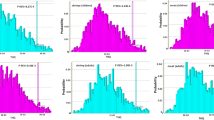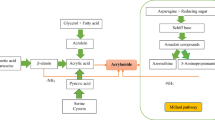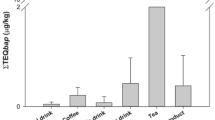Abstract
Acrylamide concentration in food products collected from the Tehran market was investigated by the aid of a dispersive liquid-liquid microextraction (DLLME) system coupled with gas chromatography-mass spectrometry (GC-MS). Also, the dietary exposure distribution and related potential risk for acrylamide ingestion were estimated by the Monte Carlo simulation (MCS). The highest and lowest mean concentration of acrylamide was detected in coffee and roasted nuts samples as 549 and 133 μg/kg, respectively. The mean acrylamide dietary exposure values for children (3–10 years), adolescents (11–17 years), adults (18–60 years), and seniors (61–96 years) were estimated to be 1.81, 1.02, 0.61, and 0.53 μg/kg body weight (BW)/day, respectively. In all age groups, except children, the estimated exposure in men and boys was higher than that in women and girls. Bread, despite containing low acrylamide content groups (157 μg/kg while compared with other, except roasted nuts), showed with the highest contribution rate in all age groups due to its high consumption rate. The estimated incremental lifetime cancer risk (ILCR) for all age groups was noted as greater than 10−4 indicating serious risk to the population. Moreover, the margin of exposure (MOE) values based on carcinogenicity showed health concern to all age groups (< 10,000). Regarding the non-carcinogenic risk, the target hazard quotient (THQ) was lower than 1, and MOE based on neurotoxicity was higher than 125 (safety thresholds), which represented negligible and ignorable risk in all age groups except in a small group of children and adolescents.

Graphical abstract







Similar content being viewed by others
References
Abtahi M, Fakhri Y, Oliveri Conti G, Ferrante M, Taghavi M, Tavakoli J, Heshmati A, Keramati H, Moradi B, Amanidaz N (2018) The concentration of BTEX in the air of Tehran: a systematic review-meta analysis and risk assessment. Int J Environ Res Public Health 15(9):1837
Ali S, Fakhri Y, Golbini M, Thakur SK, Alinejad A, Parseh I, Shekhar S, Bhattacharya P (2019) Concentration of fluoride in groundwater of India: a systematic review, meta-analysis and risk assessment. Groundw Sustain Dev 100224
Alpözen E, Üren A (2013) Determination of acrylamide levels of “Izmir gevregi” and effects of cooking parameters on acrylamide formation. J Agric Food Chem 61(30):7212–7218
Altissimi MS, Roila R, Branciari R, Miraglia D, Ranucci D, Framboas M, Haouet N (2017) Contribution of street food on dietary acrylamide exposure by youth aged nineteen to thirty in Perugia, Italy. Ital J Food Saf 6(3)
Altunay N, Gürkan R, Orhan U (2016) A preconcentration method for indirect determination of acrylamide from chips, crackers and cereal-based baby foods using flame atomic absorption spectrometry. Talanta 161:143–150
Alyousef HA, Wang H, Al-Hajj NQM, Koko MY (2016) Determination of acrylamide levels in selected commercial and traditional foods in Syria. Trop J Pharm Res 15(6):1275–1281
Amrein TM, Lukac H, Andres L, Perren R, Escher F, Amadò R (2005) Acrylamide in roasted almonds and hazelnuts. J Agric Food Chem 53(20):7819–7825
Atamaleki A, Yazdanbakhsh A, Fakhri Y, Mahdipour F, Khodakarim S, Khaneghah AM (2019) The concentration of potentially toxic elements (PTEs) in the onion and tomato irrigated by wastewater: a systematic review; meta-analysis and health risk assessment. Food Res Int 125:108518
Ayvaz H, Rodriguez-Saona LE (2015) Application of handheld and portable spectrometers for screening acrylamide content in commercial potato chips. Food Chem 174:154–162
Cengiz MF, Gündüz CPB (2013) Acrylamide exposure among Turkish toddlers from selected cereal-based baby food samples. Food Chem Toxicol 60:514–519
Chen F, Yuan Y, Liu J, Zhao G, Hu X (2008) Survey of acrylamide levels in Chinese foods. Food Addit Contam 1(2):85–92
Chen M-J, Hsu H-T, Lin C-L, Ju W-Y (2012) A statistical regression model for the estimation of acrylamide concentrations in French fries for excess lifetime cancer risk assessment. Food Chem Toxicol 50(10):3867–3876
Dadar M, Adel M, Nasrollahzadeh Saravi H, Fakhri Y (2017) Trace element concentration and its risk assessment in common kilka (Clupeonella cultriventris caspia Bordin, 1904) from southern basin of Caspian Sea. Toxin Rev 36(3):222–227
Dybing E, Sanner T (2003) Risk assessment of acrylamide in foods. Toxicol Sci 75(1):7–15
Eerola S, Hollebekkers K, Hallikainen A, Peltonen K (2007) Acrylamide levels in Finnish foodstuffs analysed with liquid chromatography tandem mass spectrometry. Mol Nutr Food Res 51(2):239–247
EFSA (2012) Update on acrylamide levels in food from monitoring years 2007 to 2010. EFSA J 10(10):2938
EFSA (2015) Scientific opinion on acrylamide in food. EFSA J 13(6):4104
Elbashir AA, Omar MMA, Ibrahim WAW, Schmitz OJ, Aboul-Enein HY (2014) Acrylamide analysis in food by liquid chromatographic and gas chromatographic methods. Crit Rev Anal Chem 44(2):107–141
EPA, U. (2010). Toxicological review of acrylamide (CAS no. 79-06-1) in support of summary Information on the Integrated Risk Information System (IRIS). EPA/635/R-07/009F, US EPA Washington, DC
Esposito F, Nardone A, Fasano E, Triassi M, Cirillo T (2017) Determination of acrylamide levels in potato crisps and other snacks and exposure risk assessment through a margin of exposure approach. Food Chem Toxicol 108:249–256
Fakhri Y, Mohseni-Bandpei A, Conti GO, Ferrante M, Cristaldi A, Jeihooni AK, Dehkordi MK, Alinejad A, Rasoulzadeh H, Mohseni SM (2018) Systematic review and health risk assessment of arsenic and lead in the fished shrimps from the Persian gulf. Food Chem Toxicol 113:278–286
Fakhri Y, Ghorbani R, Taghavi M, Keramati H, Amanidaz N, Moradi B, Nazari SH, Shariatifar N, Khaneghah AM (2019a) Concentration and prevalence of aflatoxin M1 in human breast milk in Iran: systematic review, meta-analysis, and carcinogenic risk assessment: a review. J Food Prot 82(5):785–795
Fakhri Y, Rahmani J, Oliveira CAF, Franco LT, Corassin CH, Saba S, Rafique J, Khaneghah AM (2019b) Aflatoxin M1 in human breast milk: a global systematic review, meta-analysis, and risk assessment study (Monte Carlo simulation). Trends Food Sci Technol 88:333
FAO/WHO (2011). "Evaluation of certain contaminants in food: seventy-second [72nd] report of the Joint FAO/WHO Expert Committee on Food Additives."
Fathabad AE, Shariatifar N, Moazzen M, Nazmara S, Fakhri Y, Alimohammadi M, Azari A, Khaneghah AM (2018) Determination of heavy metal content of processed fruit products from Tehran’s market using ICP-OES: a risk assessment study. Food Chem Toxicol 115:436–446
Gholami Z, Abtahi M, Golbini M, Parseh I, Alinejad A, Avazpour M, Moradi S, Fakhri Y, Mousavi Khaneghah A (2019) The concentration and probabilistic health risk assessment of nitrate in Iranian drinking water: a case study of Ilam city. Toxin Rev:1–10
Hariri E, Abboud MI, Demirdjian S, Korfali S, Mroueh M, Taleb RI (2015) Carcinogenic and neurotoxic risks of acrylamide and heavy metals from potato and corn chips consumed by the Lebanese population. J Food Compos Anal 42:91–97
Hogervorst JG, Schouten LJ, Konings EJ, Goldbohm RA, van den Brandt PA (2007) A prospective study of dietary acrylamide intake and the risk of endometrial, ovarian, and breast cancer. Cancer Epidemiol Biomarkers Prev 16(11):2304–2313
Hogervorst JG, Schouten LJ, Konings EJ, Goldbohm RA, van den Brandt PA (2008) Dietary acrylamide intake and the risk of renal cell, bladder, and prostate cancer. Am J Clin Nutr 87(5):1428–1438
IARC (1994). "IARC monographs on the evaluation of carcinogenic risks to humans." Lyon, France 60: 389–433
Keramati H, Ghorbani R, Fakhri Y, Khaneghah AM, Conti GO, Ferrante M, Ghaderpoori M, Taghavi M, Baninameh Z, Bay A (2018) Radon 222 in drinking water resources of Iran: a systematic review, meta-analysis and probabilistic risk assessment (Monte Carlo simulation). Food Chem Toxicol 115:460–469
Khoshnam F, Zargar B, Pourreza N, Parham H (2010) Acetone extraction and HPLC determination of acrylamide in potato chips. J Iran Chem Soc 7(4):853–858
Kim TH, Shin S, Kim KB, Seo WS, Shin JC, Choi JH, Weon K-Y, Joo SH, Jeong SW, Shin BS (2015) Determination of acrylamide and glycidamide in various biological matrices by liquid chromatography–tandem mass spectrometry and its application to a pharmacokinetic study. Talanta 131:46–54
Konings E, Baars A, Van Klaveren J, Spanjer M, Rensen P, Hiemstra M, Van Kooij J, Peters P (2003) Acrylamide exposure from foods of the Dutch population and an assessment of the consequent risks. Food Chem Toxicol 41(11):1569–1579
Lim H-H, Shin H-S (2014) A new derivatization approach with d-cysteine for the sensitive and simple analysis of acrylamide in foods by liquid chromatography–tandem mass spectrometry. J Chromatogr A 1361:117–124
Marconi O, Bravi E, Perretti G, Martini R, Montanari L, Fantozzi P (2010) Acrylamide risk in food products: the shortbread case study. Anal Methods 2(11):1686–1691
Mills C, Tlustos C, Evans R, Matthews W (2008) Dietary acrylamide exposure estimates for the United Kingdom and Ireland: comparison between semiprobabilistic and probabilistic exposure models. J Agric Food Chem 56(15):6039–6045
Mirmiran P, Hosseini-Esfahani F, Jessri M, Mahan LK, Shiva N, Azizi F (2011) Does dietary intake by Tehranian adults align with the 2005 dietary guidelines for Americans? Observations from the Tehran Lipid and Glucose Study. J Health Popul Nutr 29(1):39
Mojska H, Gielecińska I, Szponar L, Ołtarzewski M (2010) Estimation of the dietary acrylamide exposure of the Polish population. Food Chem Toxicol 48(8):2090–2096
Nabizadeh S, Shariatifar N, Shokoohi E, Shoeibi S, Gavahian M, Fakhri Y, Azari A, Khaneghah AM (2018) Prevalence and probabilistic health risk assessment of aflatoxins B 1, B 2, G 1, and G 2 in Iranian edible oils. Environ Sci Pollut Res 25(35):35562–35570
Nematollahi A, Kamankesh M, Hosseini H, Ghasemi J, Hosseini-Esfahani F, Mohammadi A (2019) Investigation and determination of acrylamide in the main group of cereal products using advanced microextraction method coupled with gas chromatography-mass spectrometry. J Cereal Sci 87:157
Nematollahi A, Kamankesh M, Hosseini H, Hadian Z, Ghasemi J, Mohammadi A (2020) Investigation and determination of acrylamide in 24 types of roasted nuts and seeds using microextraction method coupled with gas chromatography–mass spectrometry: central composite design. J Food Measur Charact 14:1–12
Normandin L, Bouchard M, Ayotte P, Blanchet C, Becalski A, Bonvalot Y, Phaneuf D, Lapointe C, Gagné M, Courteau M (2013) Dietary exposure to acrylamide in adolescents from a Canadian urban center. Food Chem Toxicol 57:75–83
Ölmez H, Tuncay F, Özcan N, Demirel S (2008) A survey of acrylamide levels in foods from the Turkish market. J Food Compos Anal 21(7):564–568
Olsen A, Christensen J, Outzen M, Olesen PT, Frandsen H, Overvad K, Halkjær J (2012) Pre-diagnostic acrylamide exposure and survival after breast cancer among postmenopausal Danish women. Toxicology 296(1–3):67–72
Oroian M, Amariei S, Gutt G (2015) Acrylamide in Romanian food using HPLC-UV and a health risk assessment. Food Additives & Contaminants: Part B 8(2):136–141
Pacetti D, Gil E, Frega NG, Álvarez L, Dueñas P, Garzón A, Lucci P (2015) Acrylamide levels in selected Colombian foods. Food Additives & Contaminants: Part B 8(2):99–105
Pelucchi C, Galeone C, Talamini R, Negri E, Polesel J, Serraino D, La Vecchia C (2011) Dietary acrylamide and pancreatic cancer risk in an Italian case–control study. Ann Oncol 22(8):1910–1915
Rahmani J, Fakhri Y, Shahsavani A, Bahmani Z, Urbina MA, Chirumbolo S, Keramati H, Moradi B, Bay A, Bjørklund G (2018) A systematic review and meta-analysis of metal concentrations in canned tuna fish in Iran and human health risk assessment. Food Chem Toxicol 118:753–765
Roszko MŁ, Szczepańska M, Szymczyk K, Rzepkowska M (2020) Dietary risk evaluation of acrylamide intake with bread in Poland, determined by two comparable cleanup procedures. Food Addit Contam Part B Surveill 13(1):1–9
Shahrbabki PE, Hajimohammadi B, Shoeibi S, Elmi M, Yousefzadeh A, Conti GO, Ferrante M, Amirahmadi M, Fakhri Y, Khaneghah AM (2018) Probabilistic non-carcinogenic and carcinogenic risk assessments (Monte Carlo simulation method) of the measured acrylamide content in Tah-dig using QuEChERS extraction and UHPLC-MS/MS. Food Chem Toxicol 118:361–370
Shahsavani A, Fakhri Y, Ferrante M, Keramati H, Zandsalimi Y, Bay A, Hosseini Pouya SR, Moradi B, Bahmani Z, Mousavi Khaneghah A (2017) Risk assessment of heavy metals bioaccumulation: fished shrimps from the Persian Gulf. Toxin Rev 36(4):322–330
Sirot V, Hommet F, Tard A, Leblanc J-C (2012) Dietary acrylamide exposure of the French population: results of the second French Total Diet Study. Food Chem Toxicol 50(3–4):889–894
Skog K, Alexander J (2006) Acrylamide and other hazardous compounds in heat-treated foods. Publishing, Woodhead
Svensson K, Abramsson L, Becker W, Glynn A, Hellenäs K-E, Lind Y, Rosen J (2003) Dietary intake of acrylamide in Sweden. Food Chem Toxicol 41(11):1581–1586
Taeymans D, Wood J, Ashby P, Blank I, Studer A, Stadler RH, Gonde P, Eijck P, Lalljie S, Lingnert H (2004) A review of acrylamide: an industry perspective on research, analysis, formation, and control. Crit Rev Food Sci Nutr 44(5):323–347
WHO (2002a) FAO/WHO consultation on the health implications of acrylamide in food. Summary report of a meeting held in Geneva, 25–27 June 2002. World Health Organization, Geneva
WHO (2002b) Health implications of acrylamide in food: report of a Joint FAO/WHO Consultation, WHO Headquarters, Geneva, Switzerland, 25-27 June 2002. World Health Organization, Geneva
Wyka J, Tajner-Czopek A, Broniecka A, Piotrowska E, Bronkowska M, Biernat J (2015) Estimation of dietary exposure to acrylamide of Polish teenagers from an urban environment. Food Chem Toxicol 75:151–155
Xia Z, Duan X, Qiu W, Liu D, Wang B, Tao S, Jiang Q, Lu B, Song Y, Hu X (2010) Health risk assessment on dietary exposure to polycyclic aromatic hydrocarbons (PAHs) in Taiyuan, China. Sci Total Environ 408(22):5331–5337
Xu Y, Cui B, Ran R, Liu Y, Chen H, Kai G, Shi J (2014) Risk assessment, formation, and mitigation of dietary acrylamide: current status and future prospects. Food Chem Toxicol 69:1–12
Zajac J, Bojar I, Helbin J, Kolarzyk E, Potocki A, Strzemecka J, Owoc A (2013) Dietary acrylamide exposure in chosen population of South Poland. Ann Agric Environ Med 20(2):351
Zokaei M, Kamankesh M, Abedi AS, Moosavi MH, Mohammadi A, Rezvani M et al (2020) Reduction in acrylamide formation in potato crisps: application of extract and hydrocolloid-based coatings. J Food Prot 83(5):754–761
Acknowledgments
This research has been assisted by the Department of Food Science and Technology, National Nutrition and Food Technology Research Institute, Faculty of Nutrition Sciences, Food Science and Technology, and Research Institute for Endocrine Sciences, Shahid Beheshti University of Medical Sciences, Tehran, Iran. We thankfully acknowledge their support.
Author information
Authors and Affiliations
Corresponding authors
Ethics declarations
Conflict of interest
The authors declare that they have no conflict of interest.
Additional information
Responsible editor: Philippe Garrigues
Publisher’s note
Springer Nature remains neutral with regard to jurisdictional claims in published maps and institutional affiliations.
Rights and permissions
About this article
Cite this article
Nematollahi, A., Kamankesh, M., Hosseini, H. et al. Acrylamide content of collected food products from Tehran’s market: a risk assessment study. Environ Sci Pollut Res 27, 30558–30570 (2020). https://doi.org/10.1007/s11356-020-09323-w
Received:
Accepted:
Published:
Issue Date:
DOI: https://doi.org/10.1007/s11356-020-09323-w




